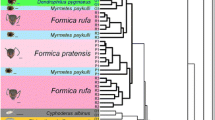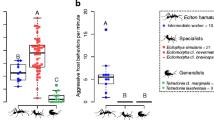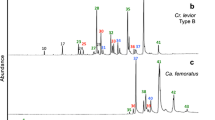Abstract
Numerous animals have evolved effective mechanisms to integrate into and exploit ant societies. Chemical integration strategies are particularly widespread among ant symbionts (myrmecophiles), probably because social insect nestmate recognition is predominantly mediated by cuticular hydrocarbons (CHCs). The importance of an accurate chemical mimicry of host CHCs for social acceptance recently has been demonstrated in a myrmecophilous silverfish. In the present study, we investigated the role of chemical mimicry in the myrmecophilous spider Gamasomorpha maschwitzi that co-occurs in the same host, Leptogenys distinguenda, as the silverfish. To test whether spiders acquire mimetic CHCs from their host or not, we transferred a stable isotope-labeled hydrocarbon to the cuticle of workers and analyzed the adoption of this label by the spiders. We also isolated spiders from hosts in order to study whether this affects: 1) their chemical host resemblance, and 2) their social integration. If spiders acquired host CHCs, rather than biosynthesizing them, they would be expected to lose these compounds during isolation. Spiders acquired the labeled CHC from their host, suggesting that they also acquire mimetic CHCs, most likely through physical contact. Furthermore, isolated spiders lost considerable quantities of their CHCs, indicating that they do not biosynthesize them. However, spiders remained socially well integrated despite significantly reduced chemical host similarity. We conclude that G. maschwitzi depends less on chemical mimicry to avoid recognition and aggressive rejection than the silverfish previously studied, suggesting that the two myrmecophiles possess different adaptations to achieve social integration.





Similar content being viewed by others
References
Akino, T. 2008. Chemical strategies to deal with ants: a review of mimicry, camouflage, propaganda, and phytomimesis by ants (Hymenoptera:Formicidae) and other arthropods. Myrmecol. News 11:173–181
Allan, R. A., Capon, R. J., Brown, W.V., and Elgar, M.A. 2002. Mimicry of host cuticular hydrocarbons by salticid spider Cosmophasis bitaeniata that preys on larvae of tree ants Oecophylla smaragdina. J. Chem. Ecol. 28:835–848
Anderson, M. J., Gorley, R. N., and Clarke, K. R. 2008. PERMANOVA+ for PRIMER: Guide to software and statistical methods. PRIMER-E, Plymouth, UK
Baer, B., Den Boer, S. P. A., Kronauer, D. J. C., Nash, D.R., and Boomsma, J. J. 2009. Fungus gardens of the leafcutter ant Atta colombica function as egg nurseries for the snake Leptodeira annulata. Insectes Soc. 56:289–291
Bagnères, A.-G., and Lorenzi, M. 2010. Chemical deception/mimicry using cuticular hydrocarbons. in: Blomquist GJ, Bagnères A-G (eds) Insect hydrocarbons: Biology, Biochemistry and Chemical ecology. Cambridge University Press, New York, USA
Bates, H.W. 1862. Contributions to an insect fauna of the Amazon Valley. Lepidoptera: Heliconidae. Trans. Linn. Soc. 23:495–566
Bauer, S., Boehm, M., Witte, V., and Foitzik, S. 2010. An ant social parasite in-between two chemical disparate host species. Evol. Ecol. 24:317–332
Brower, L. P. 1988. Mimicry and the evolutionary process. Amer. Nat. 131: Supplement S1-S121
Ceccarelli, F. S. 2007. Contact between Myrmarache (Araneae: Salticidae) and ants. Bull. Br. Arachnol. Soc. 14:54–58
Cushing, P. E. 1997. Myrmecomorphy and myrmecophily in spiders: a review. Florida Entomol. 80:165–193
Dettner, K. and Liepert, C. 1994. Chemical mimicry and camouflage. Annu. Rev. Entomol. 39:129–154
Emery, C. 1887. Catalogo dello formiche esistenti nelle collezioni del Museo Civico. Gen Insect Fasc 118:1–124
Fisher, R. A. 1927. On some objections to mimicry theory: statistical and genetic. Trans. Ent. Soc. London 75:269–278
Gotwald, W. H. Jr. 1995. Army Ants: The Biology of Social Predation. Cornell University Press, New York
Hölldobler, B. and Carlin, N. F. 1989. Colony founding, queen control and worker reproduction in the ant Aphaenogaster (=Novomessor) cockerelli (Hymenoptera: Formicidae). Psyche 96:131–151
Hölldobler, B. and Wilson, E.O. 1990. The Ants. Harvard University Press, Cambridge
Kistner, D. H. 1979. Social and evolutionary significance of social insect symbionts. pp 339–413 in: Hermann HR (ed) Social insects. Academic Press, New York.
Kroiss, J., Schmitt, T., and Strohm, E. 2009. Low level of cuticular hydrocarbons in a parasitoid of a solitary digger wasp and its potential for concealment. J. Entomol. Sci. 12:9–16
Kronauer, D. J. C. 2009. Recent advances in army ant biology (Hymenoptera: Formicidae). Myrmecol. News 12:51–65
Lambardi, D., Dani, F.R., Turillazzi, S., and Boomsma, J. J. 2007. Chemical mimicry in an incipient leaf-cutting ant social parasite. Behav. Ecol. Sociobiol. 61:843–851
Lenoir, A., D’ettorre, P., Errard, C., and Hefetz, A. 2001. Chemical ecology and social parasitism in ants. Annu. Rev. Entomol. 46:573–599
Lenoir, A., Malosse, C., and Yamaoka, R. 1997. Chemical mimicry between parasitic ants of the genus Formicoxenus and their host Myrmica (Hymenoptera, Formicidae). Biochem. Syst. Ecol. 25:379–389
Mendes, L., Von Beeren, C., and Witte, V. 2011. Malayatelura ponerophila - a new genus and species of silverfish (Zygentoma, Insecta) from Malaysia, living in Leptogenys army-ant colonies (Formicidae). Dtsch. Ent. Z. 58:193–200
Müller, J. 1878. Über die Vortheile der Mimikry bei Schmetterlingen. Zoolog. Anz. 1: 54–55
Nash, D. R., Als, T. D., Maile, R., Jones, G. R., and Boomsma, J. J. 2008. A mosaic of chemical coevolution in a large blue butterfly. Science 319:88–90
Nash, D. R., and Boomsma, J. J. 2008. Communiction between hosts and social parasites. in: d'Ettorre P, Hughes DP (eds) Sociobiology of communication an interdisciplinary approach. Oxford University Press, New York
Nelson, X. J. 2011. A predator’s perspective of the accuracy of ant mimicry in spiders. Psyche 2012; doi:10.1155/2012/168549
Ruxton, G. D., Sheratt, T., and Speed, M. 2004. Avoiding Attack: The Evolutionary Ecology of Crypsis, Warning Signals and Mimicry. Oxford University Press, New York
Steghaus-Kovac, S. 1994. Wanderjäger im Regenwald- Lebensstrategien im Vergleich: Ökologie und Verhalten südostasiatischer Ameisenarten der Gattung Leptogenys (Hymenoptera: Formicidae: Ponerinae). Dissertation, University Frankfurt, Germany
Steiger, S., Schmitt, T., and Schäfer, H. M. 2011. The origin and dynamic evolution of chemical information transfer. Proc. R. Soc. B. 278:970–979
Stein, S. E. 1999. An Integrated Method for Spectrum Extraction and Compound Identification from GC/MS Data. J. Am. Soc. Mass Spectrom. 10:770–781
Symonds, M. R. E. and Elgar, M. A. 2008. The evolution of pheromone diversity. Trends Ecol. Evol. 23:220–228
Tanner, C. J. and Adler, F. R. 2009. To fight or not to fight: context-dependent interspecific aggression in competing ants. Anim. Behav. 77:297–305
Van Zweden, J. S. and D’ettorre, P. 2010. Nestmate recognition in social insects and the role of hydrocarbons. pp 222–243 in: Blomquist GJ, Bagnères AG (eds) Insect hydrocarbons: Biology, Biochemistry and Chemical Ecology. Cambridge University Press, New York.
Vander Meer, R.K., Jouvenaz, D. P., and Wojcik, D. P. 1989. Chemical mimicry in a parasitoid (Hymenoptera: Eucharitidae) of fire ants (Hymenoptera: Formicidae). J. Chem. Ecol. 15:2247–2261
VANDER MEER, R.K. and WOJCIK, D. P. 1982. Chemical mimicry in the myrmecophilous beetle Myrmecaphodius excavaticollis. Science 218:806–808
Von Beeren, C., Maruyama, M., Hashim, R., and Witte, V. 2011a. Differential host defense against multiple parasites in ants. Evol. Ecol. 25:259–276
Von Beeren, C., Pohl, S., and Witte, V. 2012. On the use of adaptive resemblance terms in chemical ecology. Psyche, Article ID 635761, doi:10.1155/2012/635761
Von Beeren, C., Schulz, S., Hashim, R., and Witte, V. 2011b. Acquisition of chemical recognition cues facilitates integration into ant societies. BMC Ecology 11:30
Wasmann, E. 1895. Die Ameisen-und Termitengäste von Brasilien. I. Teil. Mit einem Anhange von Dr. August Forel. Verh K K Zool Bot Ges Wien 45:137–179
Wickler, W. 1968. Mimikry. Nachahmung und Täuschung in der Natur. Kindlers Universitäts Bibliothek, München
Wilson, E. O. 1990. Success and dominance in ecosystems: the case of the social insects. Excellence in ecology, 2. Ecology Institute, Oldendorf/Luhe
Witte, V., Foitzik, S., Hashim, R., Maschwitz, U., and Schulz, S. 2009. Fine tuning of social integration by two myrmecophiles of the ponerine army ant, Leptogenys distinguenda. J. Chem. Ecol. 35:355–367
Witte, V., Hänel, H., Weissflog, A., Hashim, R., and Maschwitz, U. 1999. Social integration of the myrmecophilic spider Gamasomorpha maschwitzi (Araneae: Oonopidae) in colonies of the South East Asian army ant, Leptogenys distinguenda (Formicidae: Ponerinae). Sociobiology 34:145–159
Witte, V., Leingärtner, A., Sabaß, L., Hashim, R., and Foitzik, S. 2008. Symbiont microcosm in an ant society and the diversity of interspecific interactions. Anim. Behav. 76:1477–1486
Wunderlich, J. 1994. Beschreibung bisher unbekannter Spinnenarten und -gattungen aus Malaysia und Indonesien (Arachnida: Araneae: Oonopidae, Tetrablemmidae, Telemidae, Pholcidae, Linyphiidae, Nesticidae, Theridiidae und Dictynidae). Beiträge Araneologie 4:559–579
Acknowledgements
We thank the behavioral ecology group at the LMU Munich for helpful comments on the manuscript, with special thanks to Sebastian Pohl and Andrew Bruce. Many thanks also to Sofia Lizon à l’Allemand, Max Kölbl, Magdalena Mair, and Deborah Schweinfest for assistance in the field. We are grateful for financial support from the DFG (Deutsche Forschungsgemeinschaft, project WI 2646/3).
Author information
Authors and Affiliations
Corresponding author
Rights and permissions
About this article
Cite this article
von Beeren, C., Hashim, R. & Witte, V. The Social Integration of a Myrmecophilous Spider Does Not Depend Exclusively on Chemical Mimicry. J Chem Ecol 38, 262–271 (2012). https://doi.org/10.1007/s10886-012-0083-0
Received:
Revised:
Accepted:
Published:
Issue Date:
DOI: https://doi.org/10.1007/s10886-012-0083-0




